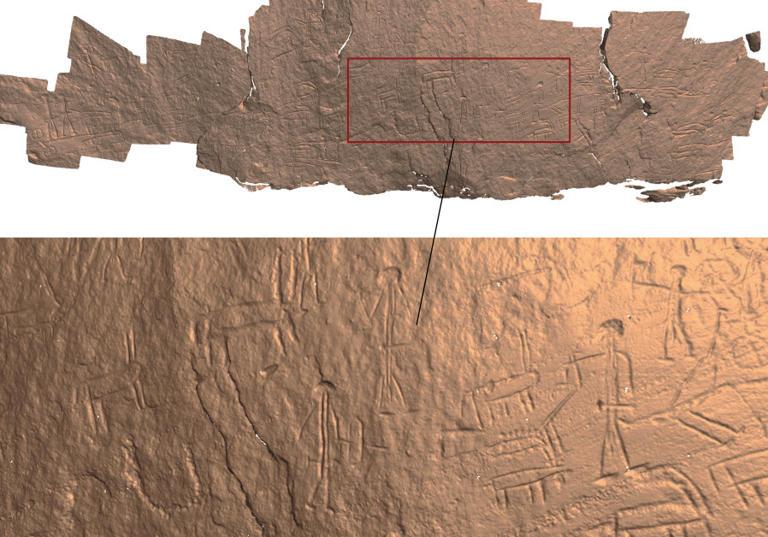New ArchCUT3-D technology explores 3-D micromorphological characteristics of engravings with unprecedented precision
THE HEBREW UNIVERSITY OF JERUSALEM
Source - https://www.eurekalert.org/news-releases/994405
 3-D model of engraved chariots in Timna Park.© (photo credit: Lena Dubinsky/Computational Archaeology Laboratory)
3-D model of engraved chariots in Timna Park.© (photo credit: Lena Dubinsky/Computational Archaeology Laboratory)
A groundbreaking study conducted by a multidisciplinary team that include a computational archaeologist, artist, and computer programmer has revealed new insights into ancient rock engravings and the techniques used by ancient engravers. The research, carried out at Site 25 in Timna Park, Southern Israel, has captivated experts and offers a fresh perspective on the production processes of these fascinating engraved rocks.
Traditionally, the study of engraved images focused on iconography, iconology, and stylistic features, overlooking the intricacies of the engraving techniques. However, this innovative research method, introduced in the study, emphasizes characterizing the techniques employed in creating rock engravings during ancient times. By considering technological variations as indicators of the engraver's production process, the team aims to enhance our understanding of these ancient artworks.
To conduct the study, 3-D scans of two ancient engravings and contemporary graffiti were obtained from Site 25 in Timna Park. These scans underwent meticulous analysis using ArchCUT3-D, specialized software developed to assess the 3-D micromorphological characteristics of the incisions forming the engravings. ArchCUT3-D enables precise and repeatable analysis by extracting 3-D slices of the incisions and examining the surface micromorphology.
The results of the research indicate that different incisions within the engravings were executed using distinct techniques. By identifying distinctive characteristics, the team successfully showcased the unique aspects of the engraving operations, such as ergonomic conditions and the consistency level of the engraving gestures.
The utilization of ArchCUT3-D software in this study represents a significant computational advancement in the field. It enables the recognition of incision techniques through micromorphology specifications and facilitates the reconstruction of engraving gestures and individual production procedures. This groundbreaking technology opens up exciting possibilities for understanding the craftsmanship and cultural significance behind ancient rock engravings.
Prof. Leore Grosman, Head of the Computational Archaeology Laboratory at the Hebrew University of Jerusalem, expressed enthusiasm for the study's findings, stating, "Our research provides a fresh perspective on ancient rock engravings by delving into the intricacies of their production processes. By unlocking the technological secrets behind these engravings, we gain valuable insights into the craftsmanship, artistic expression, and cultural context of our ancestors."
The implications of this study reach beyond the scientific community, as the newfound knowledge about ancient engraving techniques has the potential to reshape our understanding of human cultures throughout history. The team hopes that their findings will stimulate further research and inspire interdisciplinary collaborations to unravel the mysteries surrounding these ancient artworks.
The research team consisted of Prof. Leore Grosman, Head of the Computational Archaeology Laboratory, Lena Dubinsky, a doctoral candidate, and Dr. Marcelo David, all from the Hebrew University of Jerusalem.
The Hebrew University of Jerusalem is Israel's premier academic and research institution. With over 23,000 students from 80 countries, it is a hub for advancing scientific knowledge and holds a significant role in Israel's civilian scientific research output, accounting for nearly 40% of it and has received over 11,000 patents. The university's faculty and alumni have earned eight Nobel Prizes and a Fields Medal, underscoring their contributions to ground-breaking discoveries. In the global arena, the Hebrew University ranks 77th according to the Shanghai Ranking, making it the top-ranked Israeli institution. To learn more about the university's academic programs, research initiatives, and achievements, visit the official website at http://new.huji.ac.il/en
Recognizing technique variation in rock engravings: ArchCUT3-D for micromorphological analysis Nature 10.1057/s41599-023-01742-7